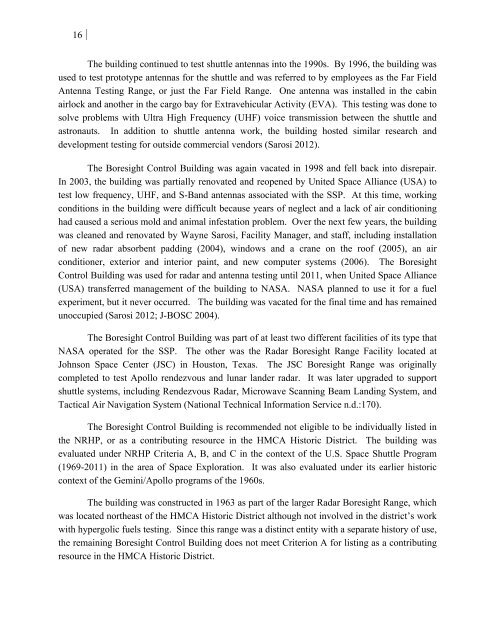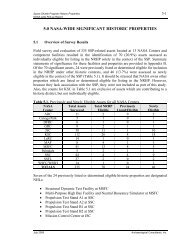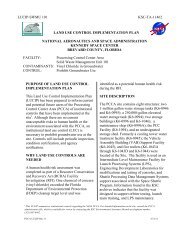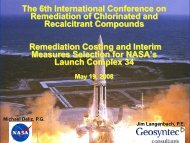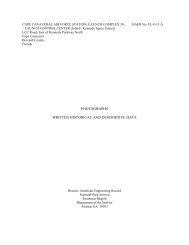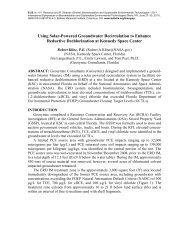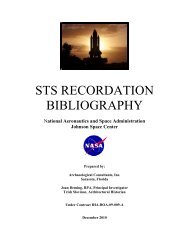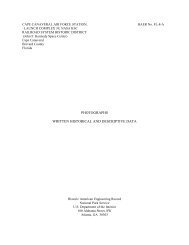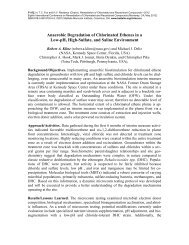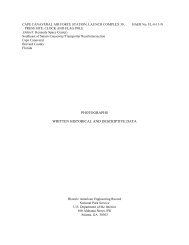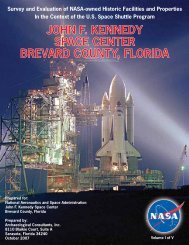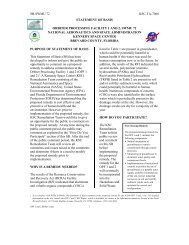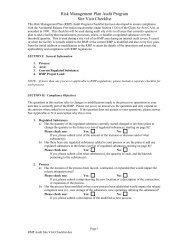HMP South & Boresight Control Building Historic Survey
HMP South & Boresight Control Building Historic Survey
HMP South & Boresight Control Building Historic Survey
You also want an ePaper? Increase the reach of your titles
YUMPU automatically turns print PDFs into web optimized ePapers that Google loves.
16The building continued to test shuttle antennas into the 1990s. By 1996, the building wasused to test prototype antennas for the shuttle and was referred to by employees as the Far FieldAntenna Testing Range, or just the Far Field Range. One antenna was installed in the cabinairlock and another in the cargo bay for Extravehicular Activity (EVA). This testing was done tosolve problems with Ultra High Frequency (UHF) voice transmission between the shuttle andastronauts. In addition to shuttle antenna work, the building hosted similar research anddevelopment testing for outside commercial vendors (Sarosi 2012).The <strong>Boresight</strong> <strong>Control</strong> <strong>Building</strong> was again vacated in 1998 and fell back into disrepair.In 2003, the building was partially renovated and reopened by United Space Alliance (USA) totest low frequency, UHF, and S-Band antennas associated with the SSP. At this time, workingconditions in the building were difficult because years of neglect and a lack of air conditioninghad caused a serious mold and animal infestation problem. Over the next few years, the buildingwas cleaned and renovated by Wayne Sarosi, Facility Manager, and staff, including installationof new radar absorbent padding (2004), windows and a crane on the roof (2005), an airconditioner, exterior and interior paint, and new computer systems (2006). The <strong>Boresight</strong><strong>Control</strong> <strong>Building</strong> was used for radar and antenna testing until 2011, when United Space Alliance(USA) transferred management of the building to NASA. NASA planned to use it for a fuelexperiment, but it never occurred. The building was vacated for the final time and has remainedunoccupied (Sarosi 2012; J-BOSC 2004).The <strong>Boresight</strong> <strong>Control</strong> <strong>Building</strong> was part of at least two different facilities of its type thatNASA operated for the SSP. The other was the Radar <strong>Boresight</strong> Range Facility located atJohnson Space Center (JSC) in Houston, Texas. The JSC <strong>Boresight</strong> Range was originallycompleted to test Apollo rendezvous and lunar lander radar. It was later upgraded to supportshuttle systems, including Rendezvous Radar, Microwave Scanning Beam Landing System, andTactical Air Navigation System (National Technical Information Service n.d.:170).The <strong>Boresight</strong> <strong>Control</strong> <strong>Building</strong> is recommended not eligible to be individually listed inthe NRHP, or as a contributing resource in the HMCA <strong>Historic</strong> District. The building wasevaluated under NRHP Criteria A, B, and C in the context of the U.S. Space Shuttle Program(1969-2011) in the area of Space Exploration. It was also evaluated under its earlier historiccontext of the Gemini/Apollo programs of the 1960s.The building was constructed in 1963 as part of the larger Radar <strong>Boresight</strong> Range, whichwas located northeast of the HMCA <strong>Historic</strong> District although not involved in the district’s workwith hypergolic fuels testing. Since this range was a distinct entity with a separate history of use,the remaining <strong>Boresight</strong> <strong>Control</strong> <strong>Building</strong> does not meet Criterion A for listing as a contributingresource in the HMCA <strong>Historic</strong> District.


